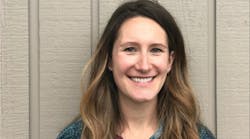The role of preventive restoratives and innovative screening technologies in caries risk management in SEARHC dental clinics
Elizabeth Mallott, RDH
Kim N. Hort, DMD
Oral health encompasses the stability of, and absence of diseases in, all structures in the mouth—from the teeth to gingival tissues, tongue to the hard palate, and other buccal and lingual tissues. Among the most preventable and reversible diseases that dental professionals see are caries and periodontal diseases.1,2 Regular visits to oral health-care professionals, combined with good hygiene that begins at a very young age, can prevent and curtail tooth decay and gum disease.
Unfortunately, several factors can increase an individual’s caries risk.3,4 These include genetic predisposition to caries and periodontal diseases, different strains of caries active bacteria that can be transmitted from person to person and which may be localized to specific geographic areas and populations, difficulty accessing inexpensive fresh fruits and vegetables and healthy foods, and lack of running water. An inability to access dental care in geographically dispersed locations also contributes to caries disease risk. Combined, these factors create barriers to good oral health.
The SEARHC caries risk program
In Southeast Alaska, however, dentists, dental hygienists, and primary dental health aides and therapists (levels 1 and 2) affiliated with the Southeast Alaska Regional Health Consortium (SEARHC) dental clinics have incorporated a multilevel approach for preventing, arresting, and treating caries disease.5 Even before CAMBRA (Caries Management by Risk Assessment) was established as the standard for caries risk assessment through disease indicators, protective protocol, and clinical interventions,6 SEARHC dental professionals began addressing the caries disease problem differently after realizing we weren’t winning the fight against cavities by drilling and filling. Rather than treat cavities according to a surgical model, we sought to treat caries disease according to a medical model, and spent considerable time researching and exploring available caries preventative and therapeutic products.
As a result, more than 12 years ago, SEARHC dental clinics implemented its caries risk program, building into it the use of glass ionomer restoratives (e.g., GC Fuji II LC, GC America) for cavity control.7 Previously, glass ionomer cements hadn’t been utilized much in our dental clinics beyond seating stainless steel full-coverage crowns.
The program plan was to bring patients in, and if they presented during the initial appointment with multiple cavities requiring fillings, we would place a glass ionomer or resin modified glass ionomer restorative (e.g., GC Fuji II LC) to stabilize their caries within one to three months. Doing so provided patients with significant fluoride protection, in addition to an excellent marginal seal to help promote remineralization.7,8
Once patients were stabilized, caries preventive therapeutics, such as fluoride varnishes (e.g., MI Varnish, GC America), iodine scrubs, and glass ionomer sealants and surface protectants (e.g., GC Fuji Triage, GC America), would be introduced to bring the patient’s mouth and oral bacteria to a healthier state. The self-bonding glass ionomer sealant and surface protectant (GC Fuji Triage) eliminates concerns about sealing over immature enamel or noncavitated lesions, and its high fluoride release results in a strong, acid-resistant fused layer.9 The varnish containing CPP–ACP (casein phosphopeptide–amorphous calcium phosphate) also helps to remineralize teeth, as well as reduce the depth of caries lesions.10
Finally, when no new cavities are developing, the glass ionomer preventives are replaced with permanent restorations, such as amalgams, full-coverage crowns, direct composites and/or glass ionomers/glass hybrid (e.g., EQUIA Forte, GC America). For direct restorations, rather than use more expensive compomers or composites, using a true glass ionomer restorative that releases significant levels of rechargeable fluoride has proven beneficial for both intermediate and long-term restorations.11,12
However, arresting caries disease in its tracks is only one component of our preventive measures. Another key aspect of our program is determining why patients are growing cavities in the first place, and beneficial to our efforts have been comprehensive salivary screenings (e.g., Saliva-Check Buffer, GC America).13 In fact, salivary screenings have played a significant role in helping us to maintain our patients’ oral health and hygiene by allowing us to identify, measure, and assess their caries risk. As a result, we’ve been able to diagnose, prevent, and correct problems associated with caries disease before tooth damage occurs.
The rewards of mitigating risk
Throughout SEARHC hub dental clinics in Sitka and Juneau—the latter of which also has an onsite Children’s Dental Clinic—as well as sub-regional and smaller dental clinics in Haines, Klawock, and Wrangell, among other outlaying communities, patients have been categorized based on their caries risk. These categories include low caries risk, moderate caries risk, and high caries risk, which is subdivided into high risk (i.e., patients with active disease) and high zero (i.e., patients with high risk factors for caries, or who have had recent previous cavities, but are now free of cavities and active disease). In the SEARHC area, about 75% of our patients in the pediatric population are either high or high zero, demonstrating that we’re treating a very caries active population. The percentage of low caries risk patients that we care for is very small, while our moderate caries risk patient population is only slightly larger.
Our program’s goal over time, therefore, is to observe a higher proportion of our patients move into the high zero category or moderate risk category, rather than be high risk with active disease. For this reason, high caries risk patients are seen every three months, with fluoride varnish applications (e.g., MI Varnish) scheduled for these patients four times per year. Of course, the ultimate goal is to not merely see the number of high zero patients increase, but to see the number of high caries risk patients decrease. However, a benchmark of our success is keeping chronically high caries risk patients cavity free.
The geographically dispersed and disconnected nature of the communities served by SEARHC can sometimes make this challenging. Many of our small communities are not connected by roads, requiring access via ferry boat or small airplane. Fortunately, our dental health aide therapists and primary dental health aides have contributed immensely to our prevention workforce in most of our communities by performing salivary screenings and primary prevention care (e.g., fluoride varnish application, oral hygiene instruction).
Conclusion
When the SEARHC Caries Risk Program first began, CAMBRA wasn’t part of mainstream conversations. Much has changed since then, and credit can be given in part to pioneering dental product manufacturers (e.g., GC America) for pushing the prevention conversation forward and making products available that address caries disease management in a different way, rather than drilling and filling. Today, dental professionals can treat a patient’s entire mouth and provide primary and secondary prevention, with the goal of helping them to become healthier.
Elizabeth Mallott, RDH, is a registered dental hygienist in Juneau, Alaska, and the dental prevention manager at SEARHC.
Kim N. Hort, DMD, heads SEARHC’s pediatric dental program, which provides special Denali KidCare clinics throughout the region. She is a diplomate with the American Board of Pediatric Dentistry.
References
1. Zanella-Calzada LA, Galván-Tejada CE, Chávez-Lamas NM, et al. A case-control study of socio-economic and nutritional characteristics as determinants of dental caries in different age groups, considered as public health problem: data from NHANES 2013-2014. Int J Environ Res Public Health. 2018;15(5). pii: E957. doi:10.3390/ijerph15050957.
2. Mertz EA. The dental-medical divide. Health Aff (Millwood). 2016;35(12):2168-2175.
3. Jepsen S, Blanco J, Buchalla W, et al. Prevention and control of dental caries and periodontal diseases at individual and population level: consensus report of group 3 of joint EFP/ORCA workshop on the boundaries between caries and periodontal diseases. J Clin Periodontol. 2017;44 Suppl 18:S85-S93.
4. Chapple IL, Bouchard P, Cagetti MG, et al. Interaction of lifestyle, behaviour or systemic diseases with dental caries and periodontal diseases: consensus report of group 2 of the joint EFP/ORCA workshop on the boundaries between caries and periodontal diseases. J Clin Periodontol. 2017;44 Suppl 18:S39-S51.
5. Senturia K, Fiset L, Hort K, et al. Dental health aides in Alaska: a qualitative assessment to improve paediatric oral health in remote rural villages. Community Dent Oral Epidemiol. 2018;46(4):416-424. doi: 10.1111/cdoe.12385.
6. Maheswari SU, Raja J, Kumar A, Seelan RG. Caries management by risk assessment: A review on current strategies for caries prevention and management. J Pharm Bioallied Sci. 2015;7(Suppl 2):S320-4. doi: 10.4103/0975-7406.163436.
7. Dunne SM, Goolnik JS, Millar BJ, Seddon RP. Caries inhibition by a resin-modified and a conventional glass ionomer cement, in vitro. J Dent. 1996;24(1-2):91-4.
8. Gjorgievska E, Nicholson JW, Iljovska S, Slipper IJ. Marginal adaptation and performance of bioactive dental restorative materials in deciduous and young permanent teeth. J Appl Oral Sci. 2008;16(1):1-6.
9. Markovic DLj, Petrovic BB, Peric TO. Fluoride content and recharge ability of five glass ionomer dental materials. BMC Oral Health. 2008;28;8:21.
10. Pithon MM, Dos Santos MJ, Andrade CS, et al. Effectiveness of varnish with CPP-ACP in prevention of caries lesions around orthodontic brackets: an OCT evaluation. Eur J Orthod. 2015;37(2):177-82.
11. Burke FJ, Bardha JS. A retrospective, practice-based, clinical evaluation of Fuji IX restorations aged over five years placed in load-bearing cavities. Br Dent J. 2013;215(6):E9.
12. Zanata RL, Navarro MF, Barbosa SH, Lauris JR, Franco EB. Clinical evaluation of three restorative materials applied in a minimal intervention caries treatment approach. J Public Health Dent. 2003;63(4):221-6.
13. Varma S, Banerjee A, Bartlett D. An in vivo investigation of associations between saliva properties, caries prevalence and potential lesion activity in an adult UK population. J Dent. 2008;36(4):294-9.








